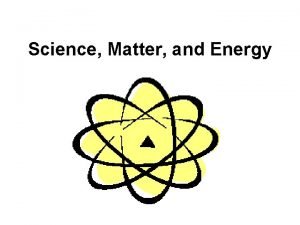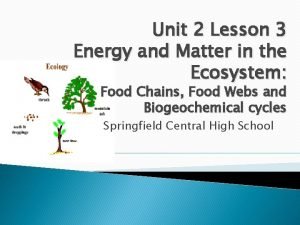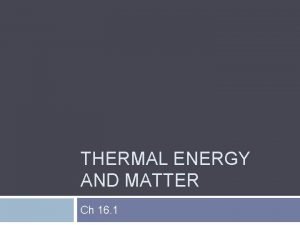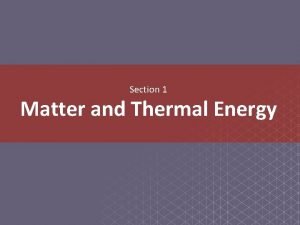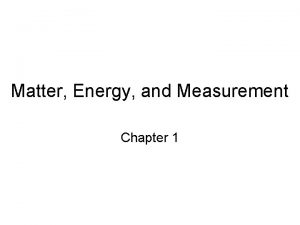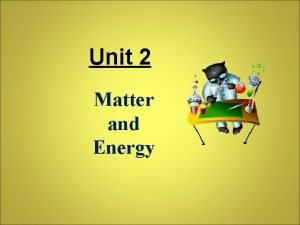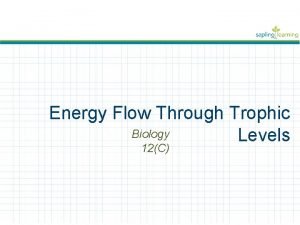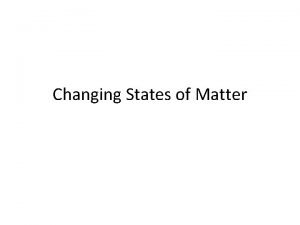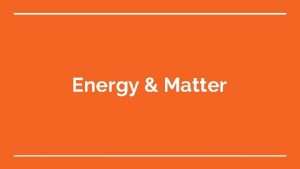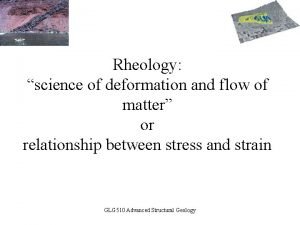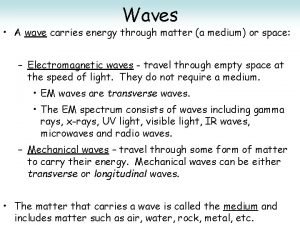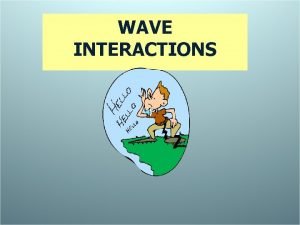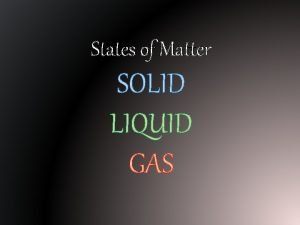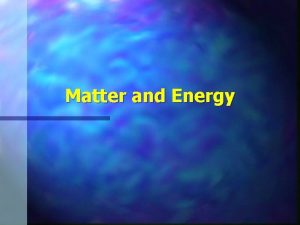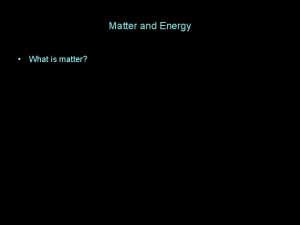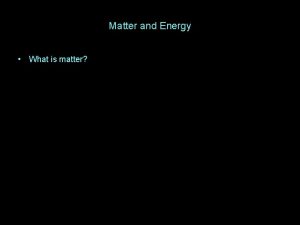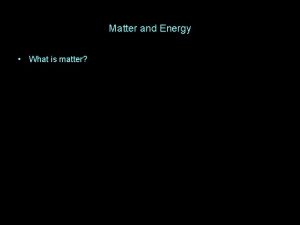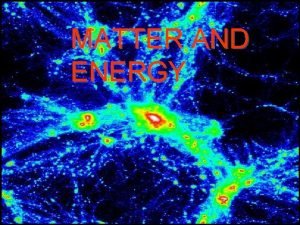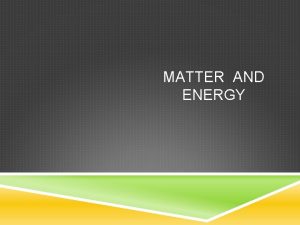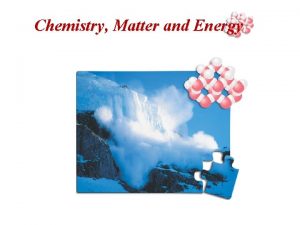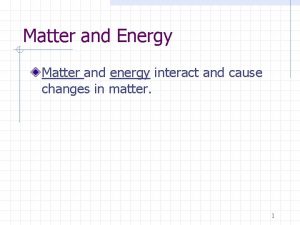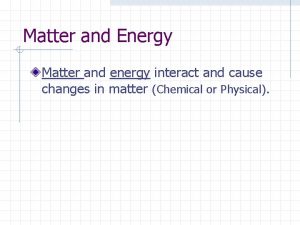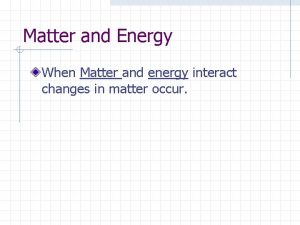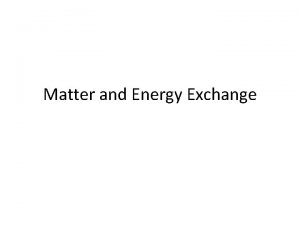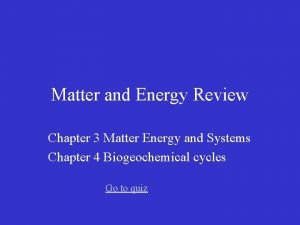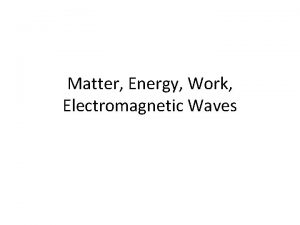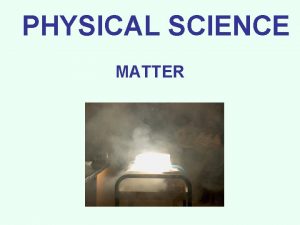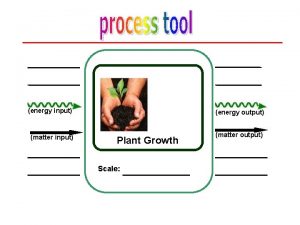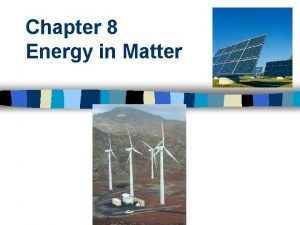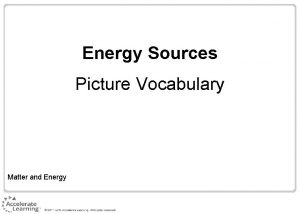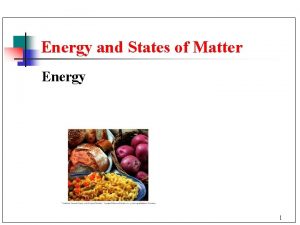Science Matter and Energy What is Science Science































- Slides: 31

Science, Matter, and Energy

What is Science? • Science is not the body of knowledge that you will learn in science classes, nor is it technology or engineering or even medicine. • Science is an organized way of looking at the world and asking questions; it’s a way of finding out information.

Scientific Method The actual approach is hypothesis testing. A hypothesis is an educated guess formulated as a statement that can be disproved.

Three Types of Scientific Methods • Experimental method involves control and experimental groups and short time spans. • Comparative method involves looking for natural experiments and testing hypotheses using them. • Modeling is a simulation of complex processes and systems.

Two Examples of Comparative Method at Work

Examples of Modeling Banana peel model of Titanic sinking Test of model with computer simulation


Theories and Paradigms A theory is wellsupported and widely accepted hypothesis that explains a set of interconnected phenomena. A theory can become a paradigm, an idea or concept so strong that it guides scientists as to what questions they ask.

• Kuhn used the duckrabbit optical illusion to demonstrate the way in which a paradigm shift could cause one to see the same information in an entirely different way

Scientific Laws A scientific or natural law is a description of what scientists find happening in nature without exception; a statement of fact about the universe that illustrates something that is always true.

Data • Scientific data are facts obtained by making observations and measurements.

Things that are science • Frontier science is that which involves preliminary results; not yet widely accepted by scientists. (life on mars) • Consensus science involves well-tested, well-supported, and widely accepted results and ideas; mainstream science. (fermentation by yeast, Chlorophyll and photosynthesis ) • Consensus science also reliable science; fringe science might get there (continental drift).

Things that are not science • Junk science are ideas that are presented as science, but are not tested and peer reviewed (research on second-hand smoking). • Pseudoscience consists of ideas that are presented as science, but are either untestable or completely disproven and are not science (Bermuda Triangle, Bigfoot). • Both are “unreliable science. ”

Chemistry Definitions • Matter is any substance that has mass and occupies space. • An element is a pure substance that cannot be broken down into other substances. (an element can have different isotopes) • Atoms are the smallest particles of an element; they cannot be broken down into smaller particles and still compose that element.

More Definitions • Compounds are substances composed of two or more elements. • Inorganic compounds do not contain carbon combined with hydrogen; characteristic of non-living things. (ammonia NH 3) • Organic compounds contain both carbons(at least two) and hydrogen, along with other elements; characteristic of living things. (glucose C 6 H 12 O 6)

Matter Quality • Matter quality is a measure of how orderly, concentrated, and useful a material is for humans. • High-quality matter is very pure and concentrated; very useful. • Low-quality matter is impure, disordered, and dilute; not useful at all.

Matter Quality at Work (sorting and recycling)

Physical Changes • physical change alters the state of matter of a material without changing the composition of a material.

Chemical Changes • Chemical changes alter the composition; i. e. , burning wood gives off water and carbon dioxide, which is not the same as the cellulose and oxygen that was there before. (chemical formula)

Laws of Matter and Energy • Matter can neither be created nor destroyed; it can merely change form (physical or chemical changes); there is no “away. ” • First law of thermodynamics—energy cannot be created or destroyed, only conserved; you can’t get ahead. • Second law of thermodynamics--energy is always converted from a higher-quality form into a lower-quality form; entropy—you can’t break even, either.

Matter and Pollution A pollutant is a substance (or energy) in food, air, water, or soil that impairs the life, health, safety, or even enjoyment of living things, including humans. Persistence is a measure of how long a pollutant lasts in the environment. -- degradable or non-persistent. -- biodegradable—require the action of living things. -- slowly degradable or persistent—DDT and CFCs as examples. -- nondegradable—plastics, lead, mercury, arsenic.

Energy • Energy is the ability to do work and transfer heat. • Kinetic energy is the energy of motion. • Heat is very low-quality energy and consists of the random motion of molecules. • Potential energy is energy stored in a system.

Energy Quality High-quality energy has a high capacity for work. Low-quality energy has a low capacity for work.

Connection between Laws of Matter and Ecology • 1. Everything is Connected to Everything Else. There is one ecosphere for all living organisms and what affects one, affects all. • 2. Everything Must Go Somewhere. There is no "waste" in nature and there is no “away” to which things can be thrown. • 3. Nature Knows Best. Humankind has fashioned technology to improve upon nature, but such change in a natural system is, says Commoner, “likely to be detrimental to that system. ” • 4. There Is No Such Thing as a Free Lunch. In nature, both sides of the equation must balance, for every gain there is a cost, and all debts are eventually paid.


High Throughput Economy

Recycling Economies • Matter-recycling and reuse economies still have high throughput, but reduce waste by re-using and recycling highquality matter and energy. • Low-throughput economies not only reduce waste, but reduce the inputs as well—much more recycling and reuse of low-quality as well as high-quality materials.

The choice is up to you.



An Example of Modeling
 Flow energy review
Flow energy review Science matter and energy
Science matter and energy What is the difference between gray and grey
What is the difference between gray and grey Cerebral aqueduct
Cerebral aqueduct Gray matter and white matter
Gray matter and white matter What is gray matter in the brain
What is gray matter in the brain Energy energy transfer and general energy analysis
Energy energy transfer and general energy analysis Energy energy transfer and general energy analysis
Energy energy transfer and general energy analysis Classification of matter section 1 composition of matter
Classification of matter section 1 composition of matter Composition of matter section 1
Composition of matter section 1 Chapter 2 matter section 1 classifying matter answer key
Chapter 2 matter section 1 classifying matter answer key Composition of matter section 1
Composition of matter section 1 Phosphorus cycle
Phosphorus cycle Section 16.1 thermal energy and matter
Section 16.1 thermal energy and matter Matter and thermal energy section 1
Matter and thermal energy section 1 Matter energy and measurement
Matter energy and measurement Dark matter and dark energy ppt
Dark matter and dark energy ppt Unit 2 matter and energy
Unit 2 matter and energy Trophic level in an ecosystem
Trophic level in an ecosystem Lesson outline lesson 1 solids liquids and gases answer key
Lesson outline lesson 1 solids liquids and gases answer key States of matter map
States of matter map Whats the study of matter and energy
Whats the study of matter and energy A matter in which waves can travel and transfer energy
A matter in which waves can travel and transfer energy Kesler science
Kesler science A graphical model of energy flow in a community
A graphical model of energy flow in a community Natural science matter and materials
Natural science matter and materials Technology grade 7 term 3 notes
Technology grade 7 term 3 notes The science of deformation and flow of matter
The science of deformation and flow of matter Grade 6 term 2 natural science
Grade 6 term 2 natural science Type of wave
Type of wave Wave transfer matter
Wave transfer matter Thermal energy states of matter
Thermal energy states of matter

